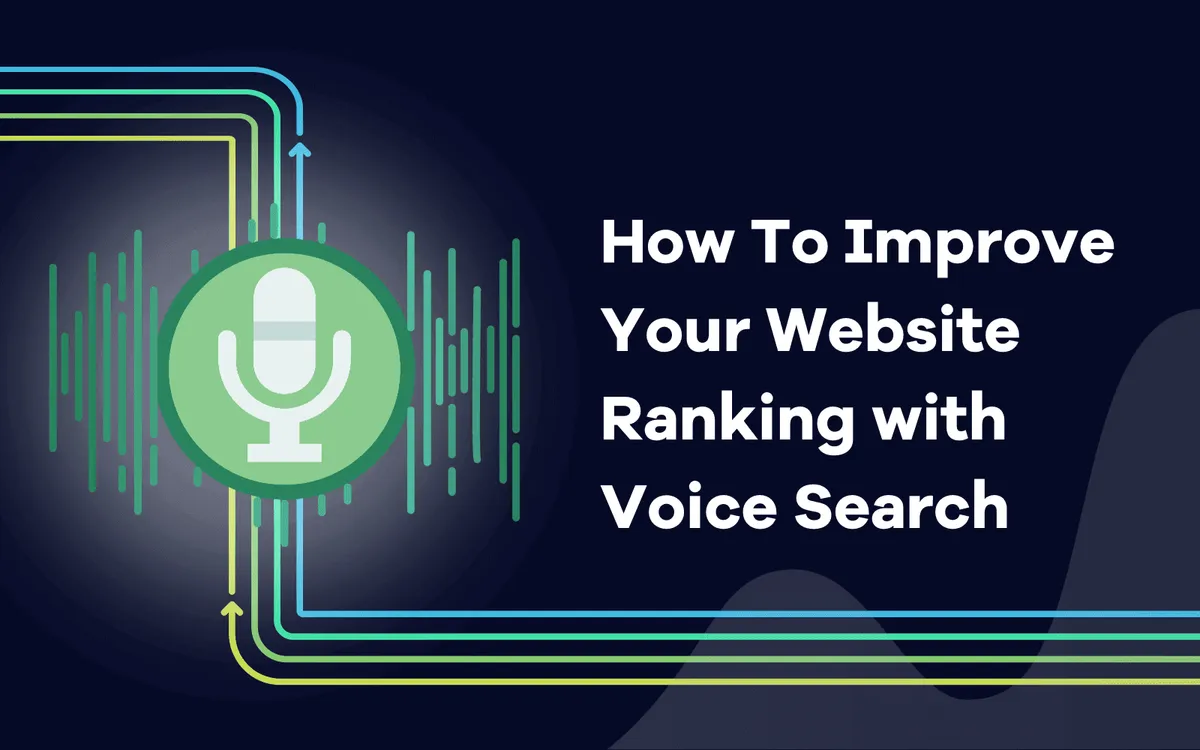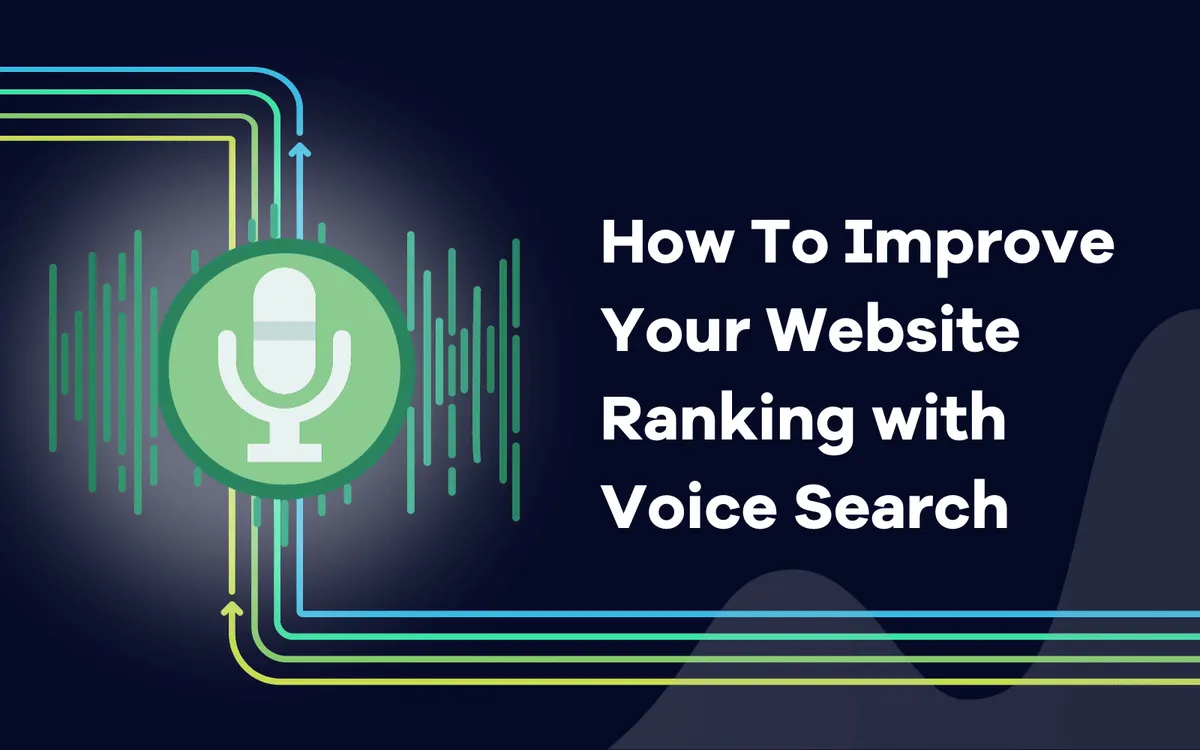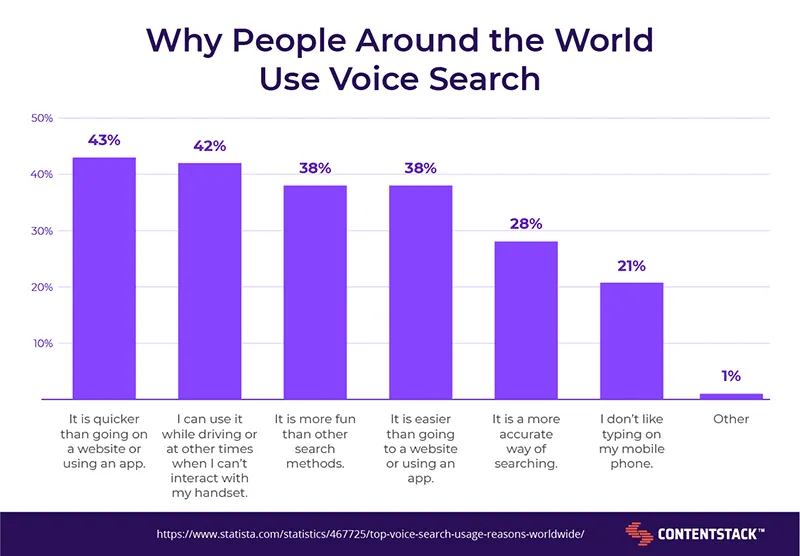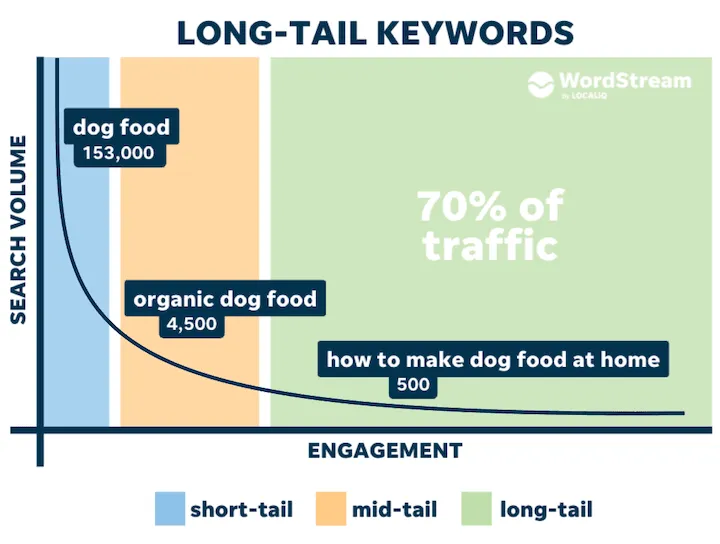
Voice Search SEO: How To Improve Your Website Ranking with Voice Search

Valentine Okoronkwo
November 24, 2023
Unlock higher website rankings with effective Voice Search SEO strategies. Learn how to optimize your content for voice searches and boost your online visibility.

Over the years, SEO has evolved into something bigger. Have you ever wanted to search for something online but preferred to say it instead of typing it because the query is too long? Suddenly, you see websites with the exact answers you are looking for.
It feels good, right?
That is the power of voice search for search engines. Voice search has changed how people seek information, find products, and interact with digital devices.
Virtual assistants such as Siri, Alexa, and Google Assistant have significantly integrated into our day-to-day activities.
Therefore, voice search SEO is a crucial strategy for business owners and marketers to reach a wider audience and provide a seamless search experience for users.
Knowing all that voice search optimization entails would help you unlock a world of opportunities for your business.
In this article, we will uncover voice search SEO, its importance, and strategies to help you as a business owner or marketer.
What is Voice Search SEO?
Voice search SEO is a marketing strategy that involves optimizing your content for voice search devices and their search engines, using optimized keywords and key phrases.
It is difficult to rank top in voice search results, mainly because voice search devices only show the top 3 results. Hence, voice search optimization is crucial.
Voice search can be traced back to the emergence of voice assistants in 2011 through the introduction of Apple's Siri. This is what marked the beginning of voice searches in mobile phones. Then smartphones, smart TVs, and smart speakers began allowing users to research on the web using voice assistants.
Over time, voice search evolved and became popular due to its convenience and reliability, thus making it part of an effective business strategy.
Now, voice search is widely used as it is more convenient than typing the search query. By 2024, it is expected that 8.4 billion people will use voice search assistants.
Importance of Voice Search SEO
Are you a business owner, digital marketer, or SEO specialist seeking to attract an increased audience through your voice search results?
If yes, here is a simplified breakdown of why it is essential to understand voice search optimization.
#1. Increased Website Traffic
Voice search optimization is a great way to drive traffic to your website or landing page. This is because it works well with optimized keywords and key phrases. Voice searches are more conversational and longer than text-based queries.
The increased traffic means more visibility and brand awareness. This increases your chances of getting more leads and customers.
Over 64% of marketers invest in organic SEO, and voice search optimization is one of the key SEO strategies to invest in.
#2. Enhanced user experience
Voice search optimization focuses on providing direct and concise answers to user queries. By optimizing content for voice search, you can deliver a better user experience by providing quick and relevant information, leading to increased user satisfaction and engagement.
Ultimately, this improved experience builds loyalty to your business. Loyal customers return more often and spread positive word of mouth. And in turn, your website can earn more money without getting stuck on the marketing treadmill.
#3. Local Relevance
Voice search often includes location-based queries. If you own a local business, you stand a better chance of reaching more potential customers within your locality. Users often use search queries like “Siri, where is the nearest bakery closer to me?” or “Hey Alexa, what are the best restaurants in Orange County?”
Additionally, voice search results are often based on location. So, use more locally-optimized keywords.
Voice Search Vs. Text Search
Voice search is all about speaking to a device to make an inquiry or ask a question rather than typing it into a keyboard or touchpad. A report from Content Stack shows that 43% of people say they prefer voice search because it is quicker than going to the website or app.

Source: Content Stack
Voice search differs from traditional text searches in how users present their concerns and interact with search engines. It is more personal and conversational than text searches. This is because of the comfort and speed that comes with it.
The hands-free nature allows users to easily voice dial and ask whatever questions they have in whatever way they choose.
The primary similarity between voice and text searches is that they are both search formats. The purpose remains to get information about a particular product or service. Through searches, whether text or voice, users can ask questions and get enough clarity about a matter.
However, voice searches were invented to simplify search processes to help improve user experience. This is possible with voice search software such as Google Assistant, Amazon's Alexa, Microsoft's Cortana, and Apple's Siri. Users can now simply speak into their devices to get answers to quick questions.
Even though voice and text searches are search formats and have the same purpose: to help provide solutions to users, they still have their differences. Let's analyze some of these differences to help you understand better;
Query Format
This refers to the structure and style of search that users input into the search engine. The query format differs because text involves typing the search query, while voice search requires the user just to say it.
Length and Complexity
Text search queries are often more concise, focusing on the essential elements of the search. It does this through the use of very detailed and targeted keywords. For example, "best smartphones," " best skin care products," "weather forecast Canada," "home decor ideas" etc.
On the other hand, voice search users speak their queries naturally, using conversational language and complete sentences. Voice searches are longer and more conversational because they are more humanized. In fact, voice searches are 3.75x faster than text searches and thus contain more words per minute.
This makes it more detailed compared to text searches. Users may ask questions or provide additional context to their queries. For example, a voice search might be "What are the best smartphones on the market right now?" or "What's the best skin care product for oily skin or dry skin?" or "What's the weather forecast for Canada tomorrow?" etc.
Natural Language
Natural language refers to the way humans naturally speak and communicate. Voice searches involve users speaking their queries conversationally and naturally. Through voice searches, users can ask questions using complete sentences and more descriptive language.
Text searches, on the other hand, typically involve users typing their queries into a search engine using concise keywords or phrases. Due to the limitations of typing, text searches often use shorter and more direct language.
Using natural language in voice searches allows users to interact with search engines more comfortably and human-likely. Instead of typing short and fragmented words, users can express their queries in a way that mirrors everyday dialogue.
User Behavior and Intent
Voice searches are commonly used when users seek immediate action or reply, like finding nearby businesses, getting directions, making reservations, or seeking quick answers to specific questions.
Text searches, on the other hand, may encompass a broader range of intents, including research, comparison, or seeking in-depth information.
Additionally, voice searches have a stronger emphasis on local intent. Users often ask for nearby businesses, services, or directions. They may use phrases like "around me" or specify a location in their voice queries. Text searches, on the other hand, may cover a broader range of topics and often not location-specific.
Strategies to Improve Your Website Rank with Voice Search SEO
As important as voice search SEO is, some strategies help to simplify the whole process. Some of these processes require a more technical approach to get them done, while the rest just need you to be more intentional about delivering your message or content.
#1. Use Long-tail Keywords
This strategy helps you connect better with the right audience, ranking your search results higher. Long-tail keywords help to communicate better to the audience because of their specificity, increasing your chances of conversions.

Source: WordStream
The phrase "dog food" might be a direct keyword, but it would not get you the desired results. It is too vague, making you lose among other brands using the same keywords.
Hence, there is a severe need for a competitive advantage in this case. Fortunately, this is where using a long-tail keyword comes in. It helps you narrow your keywords to make them very specific to you.
Long-tail keywords are the direct opposite of "head terms." Head terms are short keywords that attract a larger audience at the beginning of the search process. However, they retain only a small percentage towards the point of purchase.
The long-tail keywords are usually less broad and more specific. They might pull in less traffic than head terms but have a more significant ROI. These keywords target your target audience and people needing what you offer.
#2. Be Mobile-friendly
Research has shown that 4.32 billion out of 4.66 billion internet users are also mobile phone users. Hence, your website needs to be as mobile-friendly as possible. Mobile devices are the primary platform for voice searches.
Users often perform voice searches on their smartphones or other mobile devices while on the go.
Therefore, ensuring that your voice search results are mobile-friendly would allow you to reach and engage this audience effectively.
Mobile optimization ensures the content is displayed correctly, loads quickly, and is easy to navigate on smaller screens. It helps improve your user experience and satisfaction, encouraging them to engage with your content and increasing the likelihood of conversions or desired actions.
Mobile-friendly voice search results are crucial to increase reach and engage the growing mobile audience, provide a better user experience, and improve visibility in search results. Businesses can maximize their chances of success in the voice search territory by optimizing for mobile.
#3. Use Conversational Tone and Language
Use a more casual or friendly tone. This is because users speak to their devices as humans. So, your content needs to be in sync with their query format; otherwise, you might not rank high or even at all.
Your goal should be to appear as a human so that search engines would easily recognize your content and deliver it promptly to users.
Here are some tips that would help you sound more conversational and personal;
Watch out for your tone.
Avoid technical language.
Include personal terms such as "I," " You," and "We".
Present your message in a friendly way.
Add some sprinkles of humor.
This does not mean you should water down your content and sound like an amateur. You can still sound like an expert with a conversational tone. Aim for quality by making your delivery better and presenting your content in a way that search engines can easily capture.
#4. Use Schema Markup
Schema markup is a structured data markup language that provides additional context to search engines about the content of a webpage. It helps search engines understand the meaning and context of the information on a webpage more effectively. Schema markup uses standardized tags or code snippets to highlight specific elements on a webpage, such as products, reviews, events, recipes, etc.
Regarding voice search optimization, schema markup can provide relevant and concise information that search engines can use to generate voice search results. Here's how schema markup can be used as a voice search optimization strategy:
Rich Snippets
Schema markup can enable rich snippets. Rich snippets are modified search results that display additional information, such as ratings, reviews, images, or pricing, directly in the search results.
Rich snippets can increase your chances of being featured in voice search results and SERPs. Voice assistants often rely on these snippets to provide concise and relevant answers to user queries.
Local Business Information
Schema markup includes specific business details, such as name, address, phone number, operating hours, and customer reviews. This structured data helps search engines understand your business better and improve visibility in local voice search results.
When users ask voice queries related to businesses near their area, schema markup can ensure that voice assistants accurately display the information.
FAQ and Q&A Structured Data
Schema markup can be used to mark up frequently asked questions (FAQs) or Q&A content on a webpage. This structured data helps search engines identify and extract relevant Q&A content, making it more likely to be featured in voice search results when users ask questions about the topic.
Voice assistants often read out these Q&A responses to provide answers to voice queries.
By using schema markup as part of your voice search optimization strategy, you can provide search engines with contextually rich and ordered information.
#5. Featured Snippet
Featured snippets are summaries that appear at the top of search results, providing direct answers to user queries. They are simply "Google answer boxes" displayed on Search engine result pages (SERP).
Google picks out a part of your content that answers users' questions without them having to visit the actual page where the content resides.

Various types of featured snippets include lists, paragraphs, videos, and tables. The list featured snippets simply present content in bullet points or a list format. The paragraph-featured snippet is a formatted answer often based on specific keywords.
The table-featured snippet is a part of the content featured in a table format, and the video-featured snippet presents a short video to help answer users' questions.
The format might differ, but they all have the same purpose: to answer users' questions in the most simplified manner. The most important thing about optimizing your content for featured snippets on Google SERP is that your content needs to provide answers and solutions.
Therefore, you have to bring some level of assistance to customers and be intentional about doing that. The following tips would help you out;
Have direct answers.
Be intentional in your approach.
Structure your content through headings and tags.
Be helpful.
Keep your content between 54-58 words.
Conclusion
Voice search SEO is essential to a successful digital strategy. As voice-activated devices and voice assistants continue to shape how users search for information, you must also optimize your content to cater to this evolving search behavior.
By embracing voice search optimization, you can enhance user experience, improve visibility in search results, and capture the attention of mobile users.
So, whether you're a local business or a digital marketer, investing in voice search optimization is necessary. This would help you connect with your target audience naturally and conveniently.
The future of search is here, and it's time for business owners and marketers alike to embrace the power of voice searches.
Related blog posts

How LLMs Change Traditional SEO Metrics
Learn why rankings, CTRs, and impressions fail to measure visibility in AI-powered search — and what SEOs should track instead.
15 July 2025LLM Tracking Explained
Learn what LLM tracking is and why being mentioned in AI-generated answers is becoming a vital layer of visibility in SEO.
13 July 2025The Hidden Flaws in Search Volumes and How to Solve Them
Learn how AI Search Volume delivers reliable search volumes by combining GKP, GSC, and Trends so that you can prioritize the right keywords.
1 July 2025




